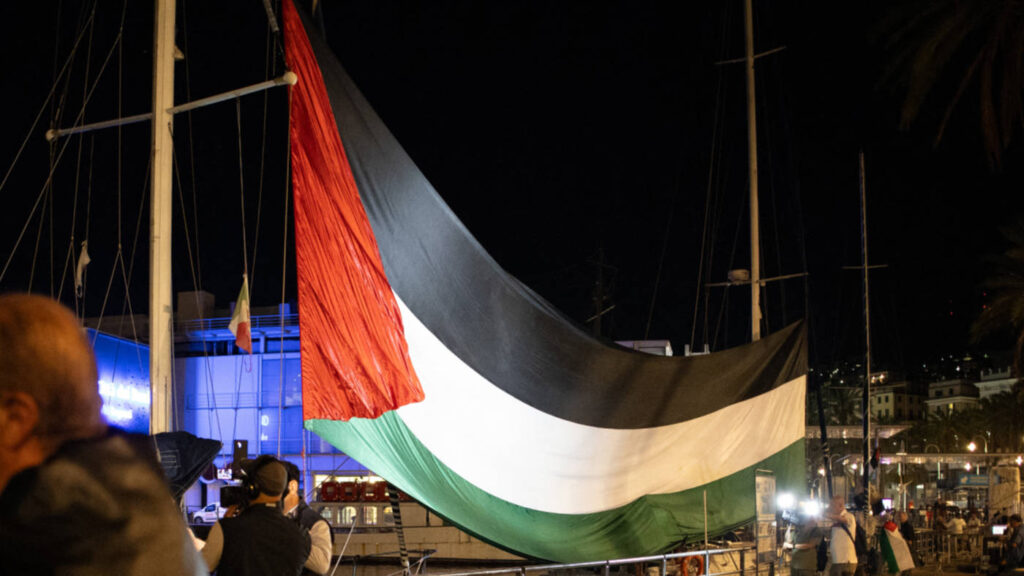The Global Sumud Flotilla has attracted worldwide attention in its bid to deliver aid to Gaza despite Israel’s ongoing naval blockade.
Bringing together more than 300 activists from 44 countries, including Swedish climate activist Greta Thunberg, the civilian flotilla is the largest maritime aid convoy to head for Gaza since Israel’s invasion of October 2023.
The flotilla was attacked by projectiles launched by drones while anchored in Tunisia on September 8 and 9. The Tunisian government described the attacks as “premeditated”.
Israel has attacked or intercepted all Gaza-bound flotillas since 2010, when the Israeli army stormed the Mavi Marmara passenger ship, killing 10 Turkish activists.
Earlier this year, two more civilian aid vessels, the Madleen and the Handala, were raided by Israeli forces in international waters.
New MEE newsletter: Jerusalem Dispatch
Sign up to get the latest insights and analysis on
Israel-Palestine, alongside Turkey Unpacked and other MEE newsletters
Middle East Eye examines the meaning of sumud – the Arabic word that lends its name to the flotilla.
What does sumud mean for Palestinians?
Sumud is usually translated from Arabic to mean “perservance”, “steadfastness” or “resilience”.
In a Palestinian context, it is more often used to mean everyday acts of resistance to Israel’s ongoing ethnic cleansing in the occupied Palestinian territories.
For some Palestinians, one manifestation of sumud could be the rebuilding of homes destroyed by Israeli bombing in Gaza.
For others, sumud might entail persistence against Israeli checkpoints in the occupied West Bank, which impose strict restrictions on where Palestinian residents can travel.
And for members of the Palestinian diaspora overseas, sumud might mean adhering to the boycott of companies that are complicit in the Israeli occupation, following the principles of the Boycott, Divestment and Sanctions (BDS) movement.
Where does the word sumud come from?
Palestinians have long resisted exclusion and erasure. In 1948, during the Nakba (the “catastrophe”), Zionist militias destroyed 530 Palestinian villages, killing 13,000 Palestinians and displacing 750,000 others. The events culminated in the unilateral declaration of Israel in May 1948.
However, modern usage of sumud is usually traced to the aftermath of the 1967 Arab-Israeli war, when Israeli captured the West Bank, the Gaza Strip and Jerusalem, as well as Syria’s Golan Heights and Egypt’s Sinai Peninsula.
An estimated 300,000 Arab residents were displaced in a series of events often referred to as the Naksa (“the setback”).
The Israeli government then encouraged settlements on Palestinian land in the annexed areas, while also targeting the civil liberties of Palestinians residents.
Israel banned displaying the Palestinian flag or even its colours. The law was lifted during the Oslo Accords in 1993, but partially brought back under far-right Israeli National Security Minister Itamar Ben Gvir in January 2023.
Meanwhile, sumud was adopted as a national symbol and promoted by the Palestine Liberation Organisation throughout the late 1960s and 1970s.
What are the symbols of sumud?
Sumud is often symbolised by the olive tree, a historic crop for Palestinians and an important part of rural Palestinian life.
Palestinian olive trees have been attacked by Israeli forces and settlers for decades, intensifying after Israel annexed the West Bank and Gaza in 1967.
Replanting olive trees is significant in Palestinian culture as an everyday act of sumud.
Are there different kinds of sumud?
Some Palestinians distinguish between two types of sumud: static sumud and resistance sumud (“sumud muqawim”).
The first focuses on the act of staying on Palestinian land amid Israeli occupation and settler incursions.
The second emphasises more dynamic acts of defiance against occupation, incorporating the non-violent forms of civil disobedience that are part of Palestinian resistance.
During the Palestinian uprising from 1987 to 1993, known as the First Intifada, acts of resistance associated with sumud included strikes, boycotts, demonstrations and non-payment of taxes.
How has sumud featured in art and literature?
The concept of sumud is often associated with the work of Palestinian lawyer, human rights activist and writer Raja Shehadeh.
In Shehadeh’s diaries of West Bank life during the 1980s, sumud is presented as the “Third Way” of resisting Israeli oppression “between mute submission and blind hate” that involves neither violent resistance nor passive acceptance.
Shehadeh wrote in The Third Way (1982): “Sumud is watching your home turn into a prison. You choose to stay in that prison because it is your home and because you fear that if you leave, your jailer will not allow you to return.”
More contemporary notions of sumud go further. Examples include Sumud: A Palestinian Reader, an anthology from more than 300 contributors about Palestinian resistance.
As the book’s preface says, sumud “is, above all, a Palestinian cultural value of everyday perseverance in the face of Israeli occupation.
“Sumud is both a personal and collective commitment; people determine their own lives, despite the environment of constant oppressions imposed upon them.”
What have flotilla organisers said about sumud?
Flotilla spokesperson Saif Abukeshek told Middle East Eye’s Khaled Shalaby before setting sail that its name was inspired by Palestine’s history of resistance.
“We look at Palestinians who have been under occupation for the past 78 years, and under this phase of genocide for 22 months, and still resist, still remain on their land, and still wake up every day looking forward to a new day in life,” said Abukeshek.
“That is resilience. That is what sumud means. So for us to be able to fight all the challenges that we face, we need to have resilience, and to be inspired by the Palestinian people.”





